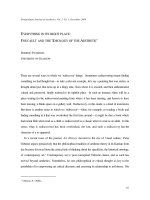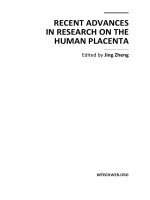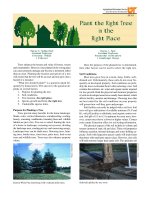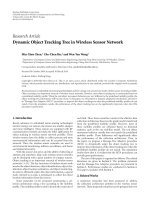plant the right tree in the right place
Bạn đang xem bản rút gọn của tài liệu. Xem và tải ngay bản đầy đủ của tài liệu tại đây (497.26 KB, 4 trang )
Plant the Right Tree
in the
Right Place
Donna C. Fare
Assistant Professor
Ornamental Horticulture
& Landscape Design
Wayne K. Clatterbuck
Assistant Professor
Forestry, Wildlife
& Fisheries
Trees enhance the beauty and value of homes, streets
and communities. However, trees planted in the wrong place
can cause property damage and become a detriment rather
than an asset. Planning the location and species of a tree
will ensure that the tree will be an asset and not grow into a
hazard or a nuisance.
“What tree should I plant?” is a question asked fre-
quently by homeowners. The answer to the question de-
pends on several factors:
1. Purpose for planting the tree.
2. Soil conditions.
3. Tree location, the right place.
4. Species growth and form, the right tree.
5. Undesirable species traits.
Purpose for Planting a Tree
Trees provide many benefits for the home landscape.
Shade, color, vertical dimension, soundproofing, cooling,
beauty, screening, windbreaks, boundary lines and wildlife
habitat are just a few. Tree use is varied: framing the view
of a house or landscape, screening out eyesores, dividing
the landscape area, creating privacy and conserving energy.
Landscape trees can be shade trees, flowering trees, fram-
ing trees, border trees, street trees, patio trees, fruit or nut
trees and wildlife trees. Trees may also enhance property
values.
Once the purpose of the planted tree is determined,
then other factors can be used to select the right tree.
Soil Conditions
Most trees grow best in a moist, deep, fertile, well-
drained soil. Unfortunately, these soils do not occur fre-
quently on developed property. Soil conditions are prob-
ably the most overlooked factor when selecting a tree. Soil
contains the nutrients, air, water and organic matter required
for tree growth. Both the physical and chemical properties
of soils in developed areas have usually been altered, which
affects fertility, aeration and drainage. Choosing trees that
are best suited for the soil conditions on your property
will govern how well they grow and prosper.
Soil fertility can easily be judged with a soil test. Soil
tests will give indications of available nutrients (N, P and
K), soil pH (acidity or alkalinity) and organic matter con-
tent. Soil pH of 5.5 to 6.5 is optimum for most trees; how-
ever, certain trees thrive at lower or higher values. Contact
your county Extension office for soil testing information.
The physical aspects of the soil include its volume and
texture (amount of sand, silt and clay). These soil properties
influence aeration, internal drainage and water-holding ca-
pacity. Soils with large pore spaces (sand) will drain faster
than those with small pore spaces (clay). However, clay soils
will hold moisture longer than sandy soils. The optimum soil
Eastern White Pine interfering with overhead utility lines.
Sidewalk uplifted by tree roots.
SP 511
2
for tree growth has a loamy texture (mixture of sand, silt and
clay) with pore spaces containing 50 percent air and 50 per-
cent water. Some tree species can better tolerate clay soils;
others are more suited to sandy soils. Compaction of the soil
decreases pore space and stresses the tree by reducing the
amount of oxygen to the roots.
Tree Location, The Right Place
Growing space both above and below ground should
be considered when selecting a tree to plant. Too often al-
lowances are not made for the increased size of the tree
when it matures.
Some of the problems that can be avoided by selecting
the proper tree for the available planting space are:
1. Damage to houses through cracked foundations, leaves
in gutters or abrasion of tree limbs hitting the house.
2. Cracked pavement of sidewalks, driveways, porches
and patios.
3. Sewer lines or septic tanks clogged by roots.
4. Dangerous screening by obscuring traffic signs, pe-
destrians or vehicles.
5. Storm damage and electrical problems from trees or
limbs affecting utility lines.
6. Blocking scenic views or windows.
One objective for planting trees in a residential set-
ting is to provide shade to cool homes during the summer
months. For morning shade, plant trees on the southeast
exposure of the house. For afternoon shade, trees should
be planted on the southwest exposure. Deciduous trees
(those that lose leaves during the winter) allow the sun to
warm the house during winter and shade it during the sum-
mer months. Evergreen trees planted on a northern ex-
posure will screen or block cold winter winds.
Remember that trees will become larger with age. Your
evaluation of the site before planting will allow you to
choose the correct size of tree for the site, avoid crowding
before it occurs and save time and money at some future
date.
Species Growth and Form, The Right Tree
Once the soil and site (location) conditions for tree
planting are determined and evaluated, then homeowners
can factor in their personal preferences when choosing a
species of tree. Characteristics such as tree shape, size,
flowering, colors and texture should be considered. For
trees to accomplish their intended purpose satisfactorily,
and to continue to do so with future growth and develop-
ment, they must be selected carefully. Properly selected
trees will become an asset to your property and require
less maintenance once established.
Hardiness. Select trees within geographic range zones 6
and 7 for planting in Tennessee (Figure 1). Trees native to
more northern climates easily withstand winters in Ten-
nessee, but are more subject to heat, scorch and sun-scald
during the hotter summer months. Conversely, trees planted
from more southern areas do well during the milder win-
ters, but are affected by extreme winters where lower tem-
peratures may kill the tree or accumulations of ice and snow
may break branches and deform the tree. Also select trees
that are more tolerant of or can adapt to adverse environ-
mental conditions (air pollution, soil compaction and poor
available moisture) frequently found in urban areas.
Small Trees
(30’ or less)
Dogwood Smoketree
Fringetree Sourwood
Hawthorn Sumac
Pawpaw Sweetbay Magnolia
Redbud Witch Hazel
Serviceberry Yellowwood
Medium Trees
(30’-70’)
American Holly Littleleaf Linden
Golden Raintree Red Maple
Green Ash Sassafras
Hackberry Silverbell
Honeylocust Sweetgum
Kentucky Coffeetree Willow Oak
Large Trees
(70’ or more)
American Beech Shumard Oak
Baldcypress Southern Magnolia
Black Cherry Sugar Maple
Black Walnut Sycamore
Cottonwood White Oak
Pines (most) Yellow-Poplar
*Adapted from Tree City USA Bulletin No. 4, National Arbor Day Foundation, Nebraska City, NE.
Size of Mature Trees*
3
Tree Shape and Form. Different species of trees have
different crown forms, such as round, oval, vaselike, weep-
ing, pyramid, columnar or spreading. Selection of a proper
form will satisfy your landscape objectives, enhance your
property and decrease future maintenance costs. Trees with
low-spreading branches are suitable for screens, but not
for placement along driveways where visability is essen-
tial. Columnar or upright trees are appropriate for medians
and property boundaries, but not for providing shade for a
house.
Tree Size, Growth and Longevity. Always plan for the
growth and future size of a tree. The small trees planted
today may be the large trees of tomorrow. Evaluate the
mature height and spread of the tree, as well as its lifespan
(see sidebars). Some trees grow and provide shade quickly
within 30 years, then decline and eventually die. How will
their decline and need for removal affect you? Yellow-pop-
lar (tuliptree) is a prime example of a tree that can grow to
a mature height of 100 feet or more, which makes it much
too large for a yard tree or urban planting. However, the
growth rate and size of the tree may be acceptable as a yard
tree during its first 50 years for shade and enjoyment. Thus,
consideration should be given to whether the tree is planted
for posterity or to fulfill an immediate need that may have
future consequences.
Sunlight. Some trees are more adapted to certain intensities
and amounts of light than others. Shade tolerance is a term
used to rate the capacity of a tree to develop and grow in the
shade of other trees. Some species, such as pines, yellow-
poplar and cottonwood require full sunlight and are consid-
ered shade-intolerant. Others, such as maple and beech pre-
fer partial shade and are called shade-tolerant. Some species
like white oak are somewhere in between and are referred to
as intermediate in tolerance. Do not make a mistake of plant-
ing your tree where its requirement for light will not be met.
Dogwood often fails as a transplant from the shade of the
forest to the bright sunlight of an open yard. Cultivated
dogwoods from nurseries are better suited for full-sun con-
ditions. Transplanting trees from native stands to personal
landscapes is not recommended.
Undesirable Species Traits
Most trees will have some undesirable traits that may
be considered obnoxious by some and tolerated by others.
Most of the unfavorable traits are associated with insects
and disease, production of fruits and seeds and tree main-
tenance.
Insects and Disease. Trees are susceptible to many in-
sects and diseases. Some trees are more vulnerable than
others. Most of these problems are species-specific and
should be considered when selecting a tree to plant. Ex-
amples of insect and disease concerns prominent in Ten-
nessee are Dutch elm disease, southern pine beetle, Japa-
nese beetle, white pine weevil, anthracnose, powdery mil-
dew, phytophthora root rot, verticillium wilt, gypsy moth,
Figure 1.
USDA hardiness zones for the southeastern United States.
Short (up to 50 years)
Bradford Pear Norway Maple
Cottonwood Silver Maple
Crabapple Redbud
Fringetree Serviceberry
Hornbeam Witch Hazel
Medium (50 to 100 years)
American Holly Littleleaf Linden
Dogwood Pines (most)
Golden Raintree Red Maple
Green Ash Sycamore
Hackberry
Long (100 or more years)
American Beech Southern Magnolia
American Elm Sugar Maple
Baldcypress White Oak
Black Walnut Yellow-Poplar
Hickories
Estimated Longevity of Selected Trees
eastern tent caterpillar, various aphids, mites, scale and
borers. Consult with your local garden center, nursery, tree
care professional, county Extension office or forester to dis-
cuss if a tree being selected is prone or sensitive to local
diseases or insects.
Fruits and Seeds. Some fruits and seeds are nuisances to
property owners, but may be valued by others. If the home-
owner is interested in providing food for wildlife, fruits and
seeds will attract many birds and animals. However, some
seed can annoy landowners. The fruit of crabapple, blackgum
and hackberry are messy when shed. Though beneficial to
wildlife, acorns, walnuts and hickory nuts are an irritation
when mowing lawns. Seed produced by yellow-poplar, maples
and redbud easily sprout in flower beds and lawns, becom-
ing a weed problem. Sweetgum and sycamore balls are un-
sightly to some homeowners and are difficult to rake. Some
of these traits are tolerable, while others are not, depending
on the perspective of the property owner.
Maintenance. Tree maintenance is an unavoidable task that
homeowners should include in their evaluation of a tree.
Most fast-growing trees will require more frequent main-
tenance than species with moderate to slow growth. The
weak wood of many fast-growing trees requires heavy
clean-up of limbs and debris after storms and may disrupt
utility service and highway traffic. Will the species selected
need major pruning to obtain the desired shape or to elimi-
nate weak crotches and other sources of structural weak-
ness? Is the tree planted in a location such as next to a house
or a driveway where pruning is necessary? Is the species
subject to insects and disease that will require treatment?
How resistant is the tree to ice and snow breakage? Will
the tree need frequent watering during dry weather? These
are a few of the maintenance questions that should be con-
sidered when selecting a tree. Once the tree is selected,
purchased and planted, considerable costs have already been
incurred. If the tree is not suited for the growing space or
location, it may not survive, resulting in a loss of time and
money. If the tree survives, but was poorly selected, the
homeowner or community will have considerable expenses
for its care. The right tree in the right place will provide
benefits for many years with minimum costs.
No one tree will fulfill all objectives within space and
time. Although tradeoffs will occur, homeowners should
integrate the various factors (purpose, soil, placement and
species) to make the best informed decision on planting
the right tree in the right place.
Insect galls (maple bladder gall mite) on silver maple leaves.
A variety of landscape materials in an attractive residential set-
ting.
Printing for this publication was funded by the USDA Forest Service through a grant with the Tennessee Department of Agricul-
ture, Division of Forestry. The Trees for Tennessee Landscapes series is sponsored by the Tennessee Urban Forestry Council.
Appreciation is expressed to Robin Young for design of this publication.
SP 511-15M-7/98 R12-4910-11-001-99









